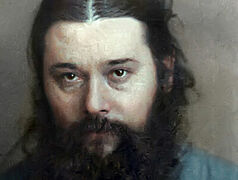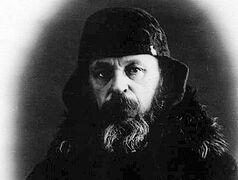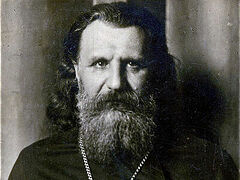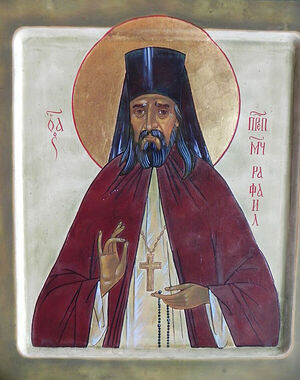 Hieromartyr Raphael (Tiupin) Holy Hieromartyr Raphael was born on July 20, 1886 in the village of Yurty, Zhernovo district, Livny region, Orlov governate, to the peasant family of George Tiupin, and was named Boris at baptism. He received his early education in the village school. In 1912, Boris entered the Kozelsk Optina Monastery of the Entrance of the Theotokos into the Temple, and was given an obedience as cook.
Hieromartyr Raphael (Tiupin) Holy Hieromartyr Raphael was born on July 20, 1886 in the village of Yurty, Zhernovo district, Livny region, Orlov governate, to the peasant family of George Tiupin, and was named Boris at baptism. He received his early education in the village school. In 1912, Boris entered the Kozelsk Optina Monastery of the Entrance of the Theotokos into the Temple, and was given an obedience as cook.
In 1914, World War I began and Boris was sent to the front. Soon after the beginning of military action he was wounded and sent to the infirmary, and then for complete recovery sent to Optina Monastery, where a military hospital had been set up. After his recovery he remained in the monastery. Once the monastery was closed by the godless authorities in 1918, Boris Georgievich was again mobilized to the front, but fell sick and remained in Livny. From there he went to Moscow, and in 1922 was tonsured a monk in the St. John Chrysostom Monastery with the name Raphael. In 1926 he was ordained a hieromonk. From 1927 to 1930, he served in the church in the village of Latynino, Kaluga diocese, and in the same year he served in the village church in Latynino, Kaluga diocese. That year he was appointed head priest of the church of the Icon of the Mother of God, “Joy of All Who Sorrow” in the village of Sharapovo, Lopasinsky region,1 Moscow diocese.
Fr. Raphael was a zealous pastor and man of prayer, and word that he was a holy man whose prayers were heard by the Lord quickly spread amongst the peasantry and they started turning to him with prayer requests and for advice. The authorities therefore decided to arrest the priest, the reader, and the church warden along with two parishioners who in their opinion were too active, accusing them of “ruining two collective farms; in connection with the acute international situation they spread rumors of war and in the related inevitable overthrow of the soviet government; they made use of hysterical women, spread rumors of the supposed punishment of peasants in connection with the difficulties they experienced for their supposed godlessness; in the church there were anti-soviet sermons, and to support them he supposedly healed2 a leper…”3
Hieromonk Raphael was arrested on April 14, 1932 and sent to a prison in the town of Serpukhov. As usual, witnesses were called in the person of representatives of the local authorities—the secretary of the Sharapovo village soviet and chairman of the collective farm, who stated that the new priest in Sharapovo had “hammered together in the parish a particular group of persons, had delegated powers so cunningly and intelligently, in order that his personal agitation would not be noticeable…4 He said in church in his sermons: ‘We are suffering a famine because we have forgotten Christ and are following in the footsteps of the antichrist. Christians must come to their senses and follow in His footsteps—God will forgive them everything.’5 He also said in his sermons that ‘the harvest in all the fields are being lost because your women are sullying them with abortions.’ Further he enjoined the believers not forget God and not follow in the steps of the antichrist.”6
One of the inhabitants called to witness expressed the opinion that the priest of their village has anti-soviet inclinations and is against the collective farms. Further he said that during a sermon in church the priest said: “Christians, aren’t you ashamed to work on the patronal feast and not go to God’s church? You can chop the wood another day… The Lord will not forgive you for this. Remember how some people burned icons with glee, and God punished them for that; He sent the frost to their grain and grass. I remind you that such a relationship to the church will not remain unpunished from on high.”7
But the OGPU was especially piqued by Fr. Raphael’s healing of the demoniac. The villagers were questioned, and they all testified that there was a sick woman who could barely be restrained by several people during fits of demonic possession, and when they brought her to Communion in the Church, it was only with great difficulty that four strong men were able to hold her steady. As for the miracle of the healing, both the faithful and the unbelieving were questioned and all confirmed that before the healing the sick woman “was unable to even bring water, and didn’t do anything around the house, just sat there like an idiot. But after she came back from Sharapovo she started working and felt no more pain.”8 The healed woman herself was also called to the investigator. She was twenty-four years old, and worked as a weaver in the institute of work education. Until 1926 she lived in the village of Novogorodovo with her parents. That year she was married and went to live with her husband in the village of Khodaevo.
She related that she had become demonically possessed when she was working in the institute, that is, after 1929. Here is how it happened. When her grandfather died, she came to his funeral. Her father was reading the Psalter for the reposed, and when he got tired she replaced him. When she came to the words, “Thou hast placed a crown upon their heads,” she fell down and began screaming with a voice that was not human, something defying description. When they finished reading the Psalter she felt extremely weak. Her grandfather’ funeral took place in the village of Khlevino. When they reached the part in the service when the clergy say, “Let all the catechumens depart”, she began to show signs of demonic possession—she was twisted and turned so violently that several grown men could hardly restrain her. When the Liturgy had ended, she couldn’t walk anywhere by herself, and so they brought her home on a horse. She couldn’t rise to her feet the next day either, and so her family started searching for some way to help her. They went to the doctors. On January 19, 1932 she was put in a hospital, and because she was pregnant at the time, they aborted the child. But then she felt even worse. Leaving the hospital on January 21, she had to go back there on January 25. The doctors who were investigating her state of health concluded that she was “suffering from neurasthenia, anemia, and tuberculosis of the lungs…”9 But they declared that although she is definitely seriously ill, they can’t help her in any way, because they don’t understand what caused such a serious illness. Then her parents turned to the priest who served in the village of Khlevino, asking him to help their daughter. He started reading prayers for her at his own home. Every time he would read the prayers, she would have fits of possession. Then her parents’ acquaintance suggested they go for help to Hieromonk Raphael who served in Sharapovo, assuring them that he was a zealous and wise pastor.
In the third week of Great Lent, on Friday, her husband brought the sick woman to Sharapovo to Fr. Raphael. The priest asked her if she had ever had any natural fits or suffer any ailments of the nervous system, because in that case he can’t really help her. Then the woman went to the church guardhouse, where Fr. Raphael soon came also. Covering her head with his epitrachelion and placing the Holy Gospels on it, he began to read a prayer. During the prayer, she started screaming in an inhuman voice. After that the priest told her husband to definitely bring her back, because she really was demonically possessed. The next day the woman was brought to the church, and every time the prayer was read she would start shouting in an inhuman voice, but Fr. Raphael would continue praying, at the same time anointing her feet, forehead, and ears with holy oil. Then she began to vomit with blood. He exorcised the demoniac six times, and each time she felt better and better. Each time he asked her, “Tell me, handmaiden of God, how many demons have come out of you and how many are left?” Whe answered that there were still many demons left in her. He would say to this, “We get rid of them.” The last time the priest read the prayer, she felt completely healthy. But he again read the prayer and anointed her with holy oil, asking if they had all come out. She replied that that was all of them, but he anointed her a second time and suddenly said, “That’s it, the last one.” Then suddenly the unclean spirit spoke out that he would leave only with blood. Fr. Raphael pried the woman’s teeth open with the holy spoon, and then she began to vomit blood. After this the priest gave the sick woman Communion, and she felt completely healthy. She threw herself at him with joy, embraced him and reverently kissed his vestments. “I didn’t pay him for it, although I offered to, but he wouldn’t take it. And now I’ll go back and work in the institute,”10 she concluded her story to the investigator.
The priest from the village of Khlevino who had made the first attempt to exorcise the woman was also called into questioning. He told the investigator that “I as a priest have seen such a healing for the first time and I can’t say how he healed her. But I would have said that it was impossible to heal someone as sick as the person I saw.”11
Fr. Raphael was also called in for questioning concerning the miracle, and he said, “With regard to the healing, I have said and still say that it wasn’t I who healed her but Jesus Christ. I am only His servant. It happened like this: Two weeks ago, a woman came to me from Novogradovo with her husband during the services… whom four men had led to Communion while she shouted in all kinds of ways, and the other people in the church started crying… and asked me to help that woman. I only said to them, ‘Pray, believing people, and the Lord will help… I exorcised her three times, and she felt better… The faithful prayed for a long time and when the woman felt better she was able to come to Communion herself, and after that she and her father and mother gathered their things and left. No one gave me the task of bringing this healing about; I have told what happened and have nothing more to tell… I don’t consider myself guilty of anything. I am the servant of the church, and I won’t leave my vocation…”12
On June 3, 1932 a Troika of the Plenipotentary Representation of the OGPU sentenced Hieromonk Raphael to three-year exile in Kazakhstan.
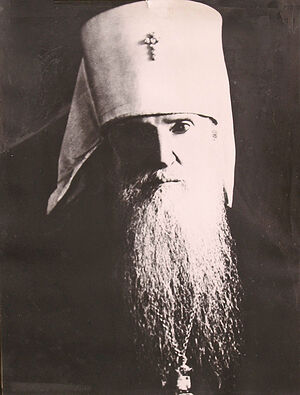 Metropolitan Theophan (Tulyakov) After serving his term, Fr. Raphael returned to Moscow and received an appointment to one of the churches in the Chernevsky region of Moscow province, where he served until 1936, at which he was sent to a church in Shakhovskoy region of the same province. In 1937, Fr. Raphael was sent to serve in a church in the Silver Ponds region. There he served for three months, trying to obtain a registration from the local authorities. But after they refused to give him a registration he again went to the Patriarchate and was sent to serve at the disposal of Metropolitan Theophan (Tulyakov) of Nizhny Novgorod, whose residence was then located in the town of Semenov. Apparently the authorities refused to give him a registration there as well, and the Metropolitan entrusted him with managing the property grounds of the diocesan administration.
Metropolitan Theophan (Tulyakov) After serving his term, Fr. Raphael returned to Moscow and received an appointment to one of the churches in the Chernevsky region of Moscow province, where he served until 1936, at which he was sent to a church in Shakhovskoy region of the same province. In 1937, Fr. Raphael was sent to serve in a church in the Silver Ponds region. There he served for three months, trying to obtain a registration from the local authorities. But after they refused to give him a registration he again went to the Patriarchate and was sent to serve at the disposal of Metropolitan Theophan (Tulyakov) of Nizhny Novgorod, whose residence was then located in the town of Semenov. Apparently the authorities refused to give him a registration there as well, and the Metropolitan entrusted him with managing the property grounds of the diocesan administration.
In August of 1937 Metropolitan Theophan was arrested, and Fr. Raphael left for the Patriarchate in Moscow, where he received an appointment to a parish in Smolensk province. But when he arrived there, the authorities refused to register him. After that, Hieromonk Raphael abandoned any further attempt to get registered at a parish. He settled in the village of Maklino, Maloyaroslavets region, Moscow province, and set about earning a living as a cobbler.
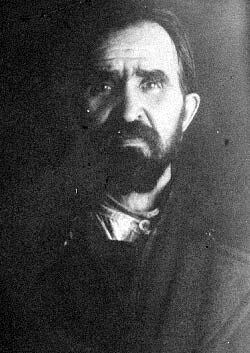 Hieromartyr Raphael (Tiupin) In late 1937, the last period of bloody persecutions began against the Russian Orthodox Church, which touched every bishop, priest, monastic, and layperson. In order to arrest Hieromonk Raphael, the NKVD questioned witnesses—the chairman of the local collection farm, a stable hand, and a sixteen-year-old-komsomol member, the son of the landlord where Fr. Raphael rented a room. They signed the protocol of questioning written by the investigator, stating that while living in their village, the priest served molebens in the homes of peasants, baptized infants, and gathered children and forced them to pray. The landlord’s son resolutely stated that the priest “terrorized the populace with his preaching against the collective farms, and corrupted discipline in them. I have made reports to the militia, but no measures have been taken against priest Tiupin to date. Tiupin is socially dangerous for the populace and the collective farms.”13
Hieromartyr Raphael (Tiupin) In late 1937, the last period of bloody persecutions began against the Russian Orthodox Church, which touched every bishop, priest, monastic, and layperson. In order to arrest Hieromonk Raphael, the NKVD questioned witnesses—the chairman of the local collection farm, a stable hand, and a sixteen-year-old-komsomol member, the son of the landlord where Fr. Raphael rented a room. They signed the protocol of questioning written by the investigator, stating that while living in their village, the priest served molebens in the homes of peasants, baptized infants, and gathered children and forced them to pray. The landlord’s son resolutely stated that the priest “terrorized the populace with his preaching against the collective farms, and corrupted discipline in them. I have made reports to the militia, but no measures have been taken against priest Tiupin to date. Tiupin is socially dangerous for the populace and the collective farms.”13
The chairman of the village soviet, having provided characteristics to the NKVD on the priest, wrote that he “is socially dangerous for the collective farm. The populace asks that he be isolated from the territory of the Maklino village soviet.”14
The chairman of the collective farm give this characteristic of Fr. Raphael: “He has conducted work to agitate the collective farms workers against going to work at the collective farms, by which he has broken the collective farm order… and corrupted discipline in the collective farm. Many of the populace have started going to church.”15
Hieromonk Raphael was arrested on November 29, 1937 and sent to a prison in Moscow. On December 2 the investigator questioned him:
“Tell me, Tiupin, did you secretly serve molebens in the houses of Maklino and baptize newborns?”
“I did not serve molebens or baptize newborns secretly.”
“Did you ever agitate women to go to church during the harvest campaign?”
“No, I didn’t agitate.”
“Tell me, did you gather little children and preach to them?”
“No, I didn’t gather children and didn’t preach to them.”
“Tell me, do you serve at the present time; and where did you get a sacred Bible, cross, and censer—and for what purpose?”
“When I was tonsured into monasticism, I was given a cross and a Gospel, and I bought the censer in Moscow in a store for three rubles… I do not plead guilty to the accusations brought against me.”
On the same day, December 2, the investigation was closed and on December 9, the NKVD Troika sentenced Fr. Raphael to execution. Hiermonk Raphael (Tiupin) was shot on December 11, 1937 and buried in a common unknown grave at the Butovo firing range, south of Moscow.
Sources: ОR Russian State Library. F. 213, k. 2, d. 3, l. 5.
State Archives of the Russian Federation. F. 10035, d. P-76230.
Federal Security Services Administration of Russia for Kaluga province. Д. П-20665.



